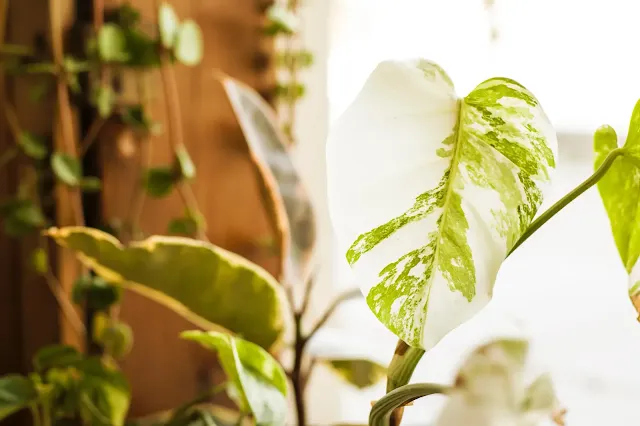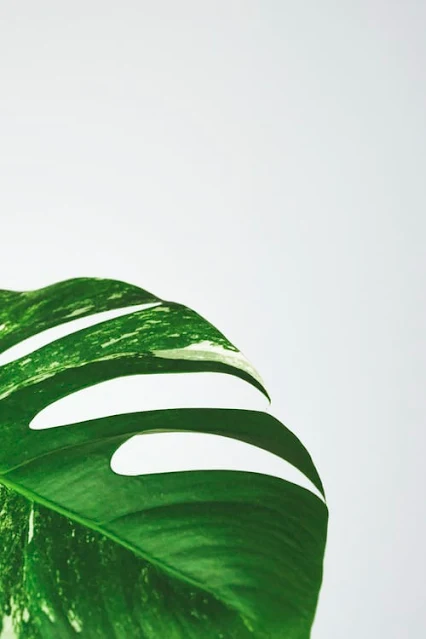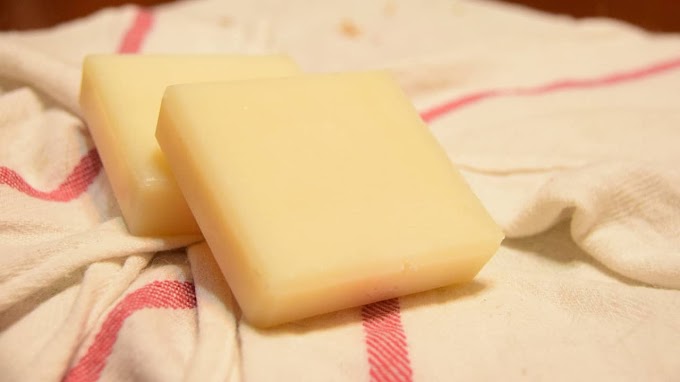Updated: November 29, 2022
Some time back I had written a detailed post on Monstera Adansonii Propagation, today in this post I am going to talk about Variegated Monstera in detail which is the cousin of Monstera Adansonii and the variegated version of Monstera Deliciosa.
Borsigiana is a smaller version of Deliciosa. It grows quickly but is still smaller than Monstera Deliciosa. The Deliciosa is developing huge leaves, while the Borsigiana leaves are quite small.
Please note, in this article, I'm going to refer to the Variegated Monstera Deliciosa as Variegated Monstera.
The variegated Monstera is a flower-bearing plant that bears fruit and relates to the Araceae family. Therefore, it is considered an Aroid. Monstera Obliqua and Peace Lilly are some examples of plants belonging to the Aroid family. The name "delicious" in English derives from the fruit of the Monstera, which tastes like a mixture of banana and pineapple and is considered a delicacy.
Variegated monstera or Swiss-cheese plant, as it is commonly called, is an epiphyte, meaning that it can grow on other plants. It lives in the tropical jungles of South America. The foliage is impressive as the divided leaves are often seen in home decor magazines, as well as Instagram posts everywhere.
WHY VARIEGATED MONSTERA HAS DIVIDED LEAVES
 |
| Variegated Monstera |
The most common explanation for split leaves and holes is that plants need to withstand heavy rain and winds in nature. However, this reasoning is speculative and is not backed by enough scientific studies.
The hollows and crevices are believed to allow plants to better withstand these conditions, as there is room for wind and water to pass through without breaking the leaves. It is just a theory at the current stage and it is unproven.
DIFFERENCE BETWEEN VARIEGATED MONSTERA AND BORSIGIANA
Also, an important differentiator between the two plants is the curly stems where the stem meets the leaf in variegated monstera once they are more mature.
Borsigiana does not develop frills on the stems. Borisigana creeper has petioles and leaves farther apart than Deliciosa. The variegated monstera has a much shorter distance between the petioles, the parts, or the stems that support the leaves.
After differentiating between these two plants, let's talk about variegation quickly. The variegation is because of the lack of chlorophyll. The most common form of variegated Monstera Deliciosa is the white form called variegated albo. There is also a yellow variegated form called Monstera Deliciosa Borsigiana Aurea.
 |
HOW TO CARE FOR VARIEGATED MONSTERA
The plant thrives in a humidity (in excess) of over 60%, well-drained soils, and temperatures between 65-80ºF (18-27ºC). Fertilize monthly during the spring and summer with a well-balanced NPK 20-20-20 fertilizer. Do not fertilize in the fall and winter months.
Soil
Bright indirect light is best. A couple of hours of direct sunlight in the morning is fine, but be careful. Too much direct light can burn and damage the leaves. The plant requires more light than the non-variegated green version.
Due to the white surface, your Deliciosa has less chlorophyll in its leaves that can be used for photosynthesis.
Water as you would most indoor plants. About once a week is sufficient in most conditions. Make sure the water drains off quickly and keep it slightly damp. The plant does not like to stay wet for long.
Wait for the soil to dry out until you water again. Your plant will spare you too much water once or twice, but it will develop root rot at some point if the roots stay too wet for too long. It is best to keep the soil slightly moist but never soggy.
 |
The best temperature range is 65-80ºF (18-27ºC). Temperatures below 50ºF (10ºC) for too long will damage your plant and stunt its growth.
The plant loves high humidity. Some people spray their plants every day. The Deliciosa definitely flourishes in high humidity, but it also tolerates it when you're not spraying your plant. The humidity requirements for the variegated version are even higher than for the pure green variant.
The Variegated Monstera can grow up to 10 feet. The Monstera plants are producing air or aerial roots that are helping the plant to fixate on other plants and trees. If you are providing your Swiss cheese plant with a moss pole the leaves will grow bigger and the stems will grow thicker and higher.
The leaves of this South American plant are green with white or yellow variegation. The amount of variegation varies greatly among plants. Some Monstera plants have very little white whilst others have big splashes that almost look like someone spilled a bucket of white paint on them.
When To Repot Potting Variegated Monstera
Drainage is the key for most plants and your variegated monstera is no exception. A drainage hole at the bottom of the pot is just fine as it will prevent soil from staying humid for too long. The leaves of a mature plant are split with slits and holes. Young plants do not have this characteristic as they develop more and more slits and holes as they mature.
The variegation is on the stem as well as on the leaves. It is possible for the plant to revert and turn entirely green again.
 |
How Much Light is Suitable For Your Variegated Monstera?
Bright indirect light is best. A couple of hours of direct sunlight in the morning is fine, but be careful. Too much direct light can burn and damage the leaves. Your plant requires more light than the non-variegated green version.
Due to the white surface, your Deliciosa has less chlorophyll in its leaves that can be used for photosynthesis.
Watering
Water as you would most indoor plants. About once a week is sufficient in most conditions. Make sure the water drains off quickly and keep it slightly damp. The Monstera does not like to stay wet for long.
Wait for the soil to dry out until you water again. Your plant will spare you too much water once or twice, but it will develop root rot at some point if the roots stay too wet for too long. It is best to keep the soil slightly moist but never soggy.
 |
Temperature
The best temperature range for the plant is 65-80ºF (18-27ºC). Temperatures below 50ºF (10ºC) for too long will damage your plant and stunt its growth.
Humidity
The plant loves high humidity. Some people spray their plants every day. The Deliciosa definitely flourishes in high humidity, but it also tolerates it when you're not spraying your plant.
The humidity requirements for the variegated version are even higher than for the pure green variant.
Fertilizer
Fertilize once a month in spring and summer with a liquid houseplant fertilizer and use half the proposed concentration. Do not fertilize in winter and fall, when the Monstera Deliciosa Varigarrada is not in growth mode. Use a well-balanced fertilizer with NPK values of 20-20-20.
Propagation
The most common propagation method is cutting stems.
This is also the only way to ensure that you are getting a perfect clone of your plant that is variegated. Propagation from seed in most cases will not lead to variegated plants, as the variety is not transmitted
Development
The Variegated Deliciosa grows to about 10 feet. Monstera plants produce air or aerial roots that help the plant fixate on other plants and trees. If you are providing your Swiss cheese plant with a moss stick, the leaves will grow larger and the stems will grow taller and taller.
The leaves of the variegated Monstera Deliciosa are green with white or yellow variegation. The amount of variegation varies greatly between plants.
Some Monstera plants have very little white, while others have large splatters that almost look like someone has spilled a bucket of white paint on them.
If a variegated Monstera Deliciosa has half-white half-green leaves, it is called crescent variegation and is considered to be even rarer than the already quite rare and hard-to-find variegated Monstera Deliciosa.
 |
Pots: Use a pot with drainage. A drainage hole in the bottom of the pot is fine, as it will prevent the soil from staying wet for too long.
Monstera Deliciosa variegated care is not much different from care for other tropical houseplants. The biggest difference we would like to point out is the increased need for light due to the need to compensate for the lack of chlorophyll.
Low light conditions are not recommended for the care of Monstera Deliciosa variegated.
COMMON PROBLEMS OF MONSTERA VARIEGATED
The plant quickly starts to look bad if your indoor plant care isn't the best. These are the most common problems and solutions:
BROWNING LEAVES
Problem: Dark and yellowish leaves can be an indicator of excess watering, in addition to having the relationship between watering and light not controlled. In particular, the browning of the white mottled areas is due to the lack of light and also to the humidity. Some people claim that it is normal, but it can certainly be prevented as we assume you would love to keep the white parts of your precious variety.
Solution: Reduce watering and make sure your plant gets enough light. Cut off the brown parts of the leaf and the white areas, as this will help reduce the chance of the browning spreading onto the leaves.
YELLOW SHEETS
Problem: The most common cause of yellowing leaves on a Monstera Deliciosa Variegata is excess water. Overwatering is so common with indoor plants that most people won't even realize they are doing it. Also, it doesn't always mean you're overwatering.
If you are using a pot without drainage holes or potting soil that is too dense and not thick enough, the roots will stay wet for too long and will not get enough oxygen. Your plant will tell you if the leaves turn yellow.
A different reason for yellowing leaves is when old leaves are about to fall off. This is when most loose leaves are first yellow and then wilt.
Solution: Check the soil and also the roots of your plant. If your soil is still soggy a week after watering, you should change your soil/pot mix of both. If the roots began to rot, you need to remove the rooted sections to prevent the rot from spreading further. Essentially no water.
 |
BROWN LEAF TIPS
Problem: The most common cause is a lack of humidity and dry air. Potted plants can also cause the tips of the leaves to brown.
Solution: Spray the leaves of your plant daily. Use a pebble tray under the planter and fill it with water. In case a Monstera is tied to the boat, switch to a bigger boat.
Mites and scales
Problem: Mites are nasty creatures that suck the sap of plants from the underside of plant leaves. These pests have the potential to destroy a plant if they occur in large populations. Look for tiny animal droplets and accumulations on the underside of your plant leaves.
Scale insects are easy to spot when mature. They are brown to black in color and also suck the sugar secret from the plant's sap. Once ripe, they are fairly easy to spot with the naked eye due to their size. There are different types of scales. Another type of scale is the white scale.
Solution: Spray your plant with a dilute soap or alcohol solution. Some people recommend neem oil. If nothing else works, consider using bug spray to prevent further spread to other plants.
COMMON QUESTIONS ABOUT VARIEGATED MONSTERA (FAQs)
HOW DO I CARE FOR A VARIEGATED MONSTERA DELICIOSA?
The care is similar to the care of a regular Monstera Deliciosa in terms of soil, temperature, and watering needs. The biggest difference is that they need more light because the plants are variegated, and even more humidity to make sure that the white variegated parts are not browning.
 |
WHAT DO I DO IF THE WHITE PARTS ON A VARIEGATED MONSTERA DELICIOSA ARE BROWNING?
Increase the humidity in the room by either spraying water on the leaves of your plant daily, by putting a pebble tray below the pot, or by using a humidifier. Make sure your Cheese plant is getting enough bright indirect light.
Use scissors to remove the browning part on the leaves to prevent further browning. Make a cut following the natural shape of the leaves.
CAN YOU GROW VARIEGATED MONSTERA FROM SEED?
This is highly unlikely. A better way is to make stem cutting as they are exact clones of the mother plant.
WHERE CAN I BUY A VARIEGATED MONSTERA DELICIOSA?
Although Variegated Monstera is still rare, they are found more and more in garden centers in different countries. Your best sources to buy one are still: Etsy, eBay, and Facebook as well as boutique online plant stores. Now, Comfort Plants has become one of the best online platforms to buy live plants.
Check the best deals (including buy 3, get 1 FREE) on the Comfort Plants Website right now!
HOW MUCH DOES A VARIEGATED MONSTERA DELICIOSA COST?
Prices range tremendously for these plants. The biggest factors seem to be where you are located. Countries, where you are paying a big premium, are New Zealand, Australia, and the USA.
Check out the best deals on Monstera and other live plants on the Comfort Plants Website right now.
WILL THE PRICE FOR THE VARIEGATED MONSTERA DECREASE OVER TIME?
As with almost everything else, economics apply also in the plant business. It is about supply and demand. The demand is still much higher than the supply. Most of the time, they are out of stock.
But as you cannot produce these exotic plants from seeds you can't really expect the prices to decrease anytime soon. However, Comfort Plants runs special discounts from time to time. You should check out the current offers on Comfort Plants.
 |
ARE THERE ANY TRUE VARIEGATED MONSTERA DELICIOSA AND NOT BORSIGIANA?
Yes, there are. The true Deliciosa form is a bigger plant with bigger leaves and certain differences such as ruffled stems where the stem meets the leaf. Although they are much more difficult to find, there are also variegated versions of the bigger brother, the true Monstera Deliciosa not Monstera Deliciosa Borsigiana.
More Frequently Asked Questions
Help! The edges of my variegated monstera are becoming brown.
This may be due to too little light or salt accumulation in the water. The white parts of the leaves of this plant do not contain chlorophyll and cannot aid in photosynthesis. Therefore, a variegated monstera requires a higher light position than a non-variegated Monstera.
Also, because this variety is sensitive to salt accumulation, it is best to leave it uncovered for 24 hours before watering the plants. Many minerals and chemicals evaporate, preventing brown tips from forming.
Help! My variegated monstera is turning yellow!
If the leaves turn yellow, there are many things that can be causing it. First, make sure your variegated monstera is getting optimum water and light. Yellowing can often be the first sign of excess water. If you eliminate these as a possibility, Monstera may take root and need to be placed in a larger container.
You can tell if it is rooted when the non-aerial roots are exposed above the top layer of soil and appear to rotate around the pot in search of a new home. Most Monsteras need to be replanted in one size approximately every two years.
 |
| A big & beautiful leaf of Variegated Monstera |
There are these weird brown leafless growths coming out of my variegated Monstera. Is it normal?
Yes! They are roots in the air and are perfectly normal. In nature, these support plants, which allows them to climb and reach more light. The roots do not damage the walls or surfaces and can be removed whenever they get out of hand.
How fast does my plant grow?
The growth of your plant depends on access to light and water. Under ideal conditions of bright indirect light and constant humidity, Monsteras can grow 1-2 feet a year. Keep in mind that Monstera's natural growth pattern is creeping rather than vertical growth.
My Variegated Monstera has grown too big. What can I do?
Pruning! These guys are very tough and can handle good trim. You can also use stakeholders and ties to train Monstera to grow the way your mind wants.
Can Variegated Monstera be placed next to an air conditioner/heater?
The versatile Monsteras are tropical plants that prefer a humid environment. If the conditions are too dry, the leaves will fall off. Monsteras thrive in air-conditioned apartments, but always avoid placing them in the direct fire of air-conditioned or heating units. If the leaves are moving in the air, it is advisable to look elsewhere.
How often do you need to fertilize your plants?
House plants generally thrive when fertilized from spring to autumn. Fertilize once a month with organic house plant fertilizer according to the package instructions for dilution and administration. Greenery NYC uses an organic potting mix that contains sustained-release fertilizer in the soil, so plants do not need fertilizer for the first 6 months after receiving it.
How often do my plants need to be transplanted?
For larger floor plants, it is recommended to transplant every 18-24 months. Generally, you should choose a larger potting container with a diameter of 2 to 4 inches to allow growth. Do not choose a pot that is much larger than the previous pot as it can clog the roots of the plant.
If you want to keep the current size of the plant, transplant it into the same container, provide new soil, and trim some roots and leaves. Spring or summer is an ideal time to transplant, as the plants are the strongest.
Hope you found this detailed guide useful. I would love to hear from you people, go on and comment or write back!



![How The Healing Touch of Bageshwar Dham Sarkar Cured Lakhmi's Backpain Miraculously! [Video Included]](https://blogger.googleusercontent.com/img/b/R29vZ2xl/AVvXsEg01rHPfpiVWhtGNBen7_nOt1E7bW9Sh2rUs0jqRwBxoXp0m6igwodfQunEnIEbvWH2c_U0raE_pETCAjU73Bhw-85UdPBSay6b-hcMVsFHu_dTYduJa38tZFyS4ibB4m4mQBq-1wZOWYxACIBbpq76BNvXH8uEuLjWvdjmGSVTBQJK0s8i4bKhUWPA1pU/w680/baba%20bageshwar%20dham%2028%20june%20(1).jpg)





.png)